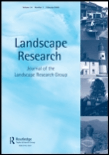
Landscape Research
Scope & Guideline
Advancing Sustainable Practices for Our Landscapes
Introduction
Aims and Scopes
- Interdisciplinary Landscape Studies:
The journal emphasizes an interdisciplinary approach to landscape research, integrating perspectives from geography, ecology, sociology, and art to understand landscapes in their full complexity. - Cultural and Historical Analysis:
It focuses on the cultural and historical dimensions of landscapes, examining how narratives, memory, and identity are constructed through landscapes across different societies. - Ecological and Environmental Perspectives:
Research published in the journal often highlights ecological concerns, investigating the relationships between landscapes and issues such as biodiversity, climate change, and sustainability. - Community Engagement and Participation:
The journal encourages studies that involve community participation in landscape planning and management, emphasizing the importance of local knowledge and social equity. - Innovative Methodologies:
'Landscape Research' promotes innovative research methodologies, including qualitative and quantitative approaches, participatory methods, and the use of technology such as GIS and remote sensing.
Trending and Emerging
- Anthropocene Landscapes:
A growing number of publications are exploring landscapes in the context of the Anthropocene, focusing on human-induced changes and the interplay between nature and culture in shaping contemporary landscapes. - Biodiversity and Urban Ecology:
Research on biodiversity within urban settings is on the rise, emphasizing the role of urban landscapes in supporting ecological networks and enhancing urban resilience to environmental changes. - Participatory and Inclusive Planning:
There is an increasing focus on participatory planning processes that engage communities in decision-making about their landscapes, highlighting the importance of local voices in shaping sustainable futures. - Cultural Narratives and Memory in Landscapes:
Emerging studies are investigating how cultural narratives and collective memories are embedded in landscapes, reflecting a deeper understanding of identity and place attachment. - Climate Change Adaptation Strategies:
The journal is increasingly featuring research on adaptive strategies for landscapes in response to climate change, including resilience planning, sustainable land use, and the integration of green infrastructure.
Declining or Waning
- Traditional Landscape Architecture:
There has been a noticeable decline in papers solely focused on traditional landscape architecture practices, as the field increasingly embraces broader ecological and social contexts rather than focusing narrowly on design aesthetics. - Historical Landscape Preservation:
Research centered on historical preservation techniques has decreased, possibly due to a growing interest in contemporary and adaptive approaches to landscape management that prioritize dynamic rather than static interpretations. - Urban Planning as a Standalone Discipline:
The journal has seen a waning interest in treating urban planning as a separate entity from landscape studies, reflecting a trend towards integrating urban planning within broader landscape research frameworks. - Conventional Environmental Impact Assessments:
There is a declining focus on traditional environmental impact assessments, as researchers are moving towards more integrated and participatory approaches that consider social and cultural dimensions alongside ecological factors. - Aesthetic Theories of Landscape:
Theoretical discussions purely focused on aesthetic evaluations of landscapes are becoming less common, as the journal shifts towards more comprehensive analyses that incorporate emotional, social, and ecological aspects.
Similar Journals
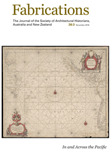
Fabrications-The Journal of the Society of Architectural Historians Australia and New Zealand
Unveiling the Rich Tapestry of Architectural HistoryFabrications - The Journal of the Society of Architectural Historians Australia and New Zealand is a vital scholarly platform that explores the rich interplay between architecture and its historical context within the Australasian landscape. Published by Routledge Journals, Taylor & Francis Ltd, this journal serves as a crucial resource for researchers, professionals, and students in the fields of architectural history, urban studies, and visual arts. With an ISSN of 1033-1867 and an E-ISSN of 2164-4756, Fabrications has received recognition for its quality, placing in the Q4 category in Urban Studies and Q2 in Visual Arts and Performing Arts as of 2023. This journal not only welcomes innovative research articles but also encourages the exploration of New Zealand and Australian cultural heritage through diverse architectural narratives. With publications spanning significant years since its inception in 1989, Fabrications continues to provide an open forum for dialogue and discovery, catering to the academic and professional community's growing interest in architectural narratives through a regional lens.
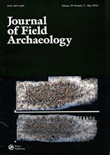
JOURNAL OF FIELD ARCHAEOLOGY
Advancing Discoveries, Connecting Past and PresentJOURNAL OF FIELD ARCHAEOLOGY, published by Routledge Journals, Taylor & Francis Ltd, is a premier scholarly publication dedicated to advancing the field of archaeology. With an impressive impact factor reflecting its significant contributions to both the arts and humanities, this journal ranks in the Q1 category for archaeology, with a remarkable position of #21/413 in the arts and humanities realm and #19/354 in social sciences, placing it in the 95th percentile among its peers. Catering to researchers, professionals, and students alike, the journal has continuously explored critical archaeological questions since its inception in 1974, with a commitment to disseminating high-quality research and innovative methodologies up to the present. Although it operates under a traditional access model, the journal engages a broad readership with its insightful studies and findings, making it an essential resource for anyone deeply involved in archaeology and its related disciplines.

Ri Vista-Ricerche per la Progettazione del Paesaggio
Exploring Interdisciplinary Solutions in Landscape ArchitectureRi Vista-Ricerche per la Progettazione del Paesaggio is a prominent academic journal published by FIRENZE UNIV PRESS that focuses on interdisciplinary research and innovative practices in the fields of Architecture, Urban Studies, and Environmental Science. Since its establishment, the journal has embraced the Open Access model, facilitating broader dissemination of knowledge and supporting global accessibility since 2003. Recognized for its contributions to landscape design and sustainability, Ri Vista holds a Q4 ranking across multiple categories in 2023, indicating its evolving role in addressing pressing issues of urban planning, environmental management, and conservation. The journal provides a platform for emerging ideas and methodologies, promoting scholarly dialogue among researchers, professionals, and students, and thus playing a crucial role in shaping the discourse surrounding contemporary landscape architecture. With a commitment to fostering innovation and supporting sustainable practices, Ri Vista is indispensable for those engaged in the intricate relationships between the built environment and the natural world.

i2 Investigacion e Innovacion en Arquitectura y Territorio
Connecting research and real-world applications in dynamic landscapes.i2 Investigacion e Innovacion en Arquitectura y Territorio is a leading open-access journal published by the University of Alicante, dedicated to advancing research and innovation in the fields of architecture and territorial development. Since its inception in 2013, this journal has aimed to provide a robust platform for scholarly discourse, promoting interdisciplinary approaches that connect academic insights with practical applications in urban planning and environmental design. With its commitment to accessibility, the journal ensures that cutting-edge findings and case studies are readily available to researchers, professionals, and students alike, fostering collaboration and informed decision-making. As the landscape of architecture and geography continues to evolve, the i2 journal stands out as a crucial resource for enhancing knowledge and cultivating innovative practices in these dynamic fields.
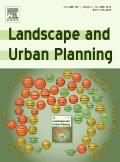
LANDSCAPE AND URBAN PLANNING
Exploring the intersection of ecology and urban design.Landscape and Urban Planning is a premier academic journal published by Elsevier, dedicated to the interdisciplinary study of urban environments and landscape management. With a strong focus on ecological, managerial, and policy-driven aspects of urban and landscape planning, this journal has achieved a remarkable recognition within its field, boasting a Q1 classification in multiple categories, including Ecology, Urban Studies, and Nature and Landscape Conservation, as evidenced by its impressive Scopus rankings. Researchers can access state-of-the-art studies and innovative methodologies that address contemporary challenges in urbanization and environmental sustainability. Since its inception in 1986, the journal has been instrumental in shaping the discourse on landscape and urban planning, making it an essential resource for academics, professionals, and students alike who seek to contribute to the sustainable development of urban areas. The journal's accessible content, backed by a strong editorial board and rigorous peer-review process, ensures that published findings remain at the forefront of research in these critical disciplines.

Ecological Questions
Exploring the Frontiers of Ecological Knowledge.Ecological Questions is a distinguished academic journal published by WYDAWNICTWO UNIWERSYTETU MIKOLAJA KOPERNIKA, dedicated to the diverse and evolving field of ecology. With ISSN 1644-7298 and E-ISSN 2083-5469, this journal promotes the dissemination of high-quality research and innovative methodologies in ecological modeling, evolutionary studies, and geographical planning. Its ongoing publication, active from 2002 to 2024, reflects its commitment to fostering interdisciplinary dialogue among ecologists and related scientists. Currently categorized in Q3 across several fields, including Ecology and Ecological Modeling, Ecological Questions serves as a vital resource for both emerging and established researchers, providing insight into current environmental challenges and theoretical advancements. Access to this journal enhances the knowledge base within academia, equipping professionals and students alike with essential information to advance their work and studies in ecology.
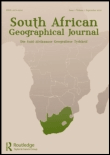
South African Geographical Journal
Pioneering scholarship in the heart of geographical sciences.The South African Geographical Journal, published by Routledge Journals, Taylor & Francis Ltd, is a leading scholarly platform dedicated to advancing research in the fields of geography, planning, and development. With an impressive history spanning from 1931 to 2024, this journal not only retains its relevance in the academic community but also proudly holds a Q2 rank in both Earth and Planetary Sciences and Geography, Planning and Development, marking it as a significant contributor to the scholarly discourse. The journal is ranked in the top 32% of its category within Scopus, affirming its stature among researchers and professionals. Although it currently does not offer Open Access, the journal provides a critical forum for the exchange of ideas, methodologies, and findings, encouraging dialogue that informs policy and practice in the geographical sciences. Readers can expect a rich variety of articles that encompass both theoretical and practical aspects of geography, making it essential for academics and practitioners alike.
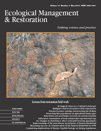
ECOLOGICAL MANAGEMENT & RESTORATION
Elevating biodiversity: A journal for change-makers.Ecological Management & Restoration is a premier international journal published by Wiley, dedicated to advancing the fields of ecology, environmental management, conservation, and restoration practices. With an impact factor that positions it in the Q2 category across various ecological and management domains, this journal serves as a critical platform for researchers and professionals seeking to address contemporary issues related to ecosystem health, biodiversity, and sustainable management. Covering a wide range of topics from ecological restoration techniques to policy impacts on nature conservation, the journal caters to a diverse audience and contributes to the scientific community's understanding of environmental challenges. Importantly, the journal provides significant visibility, ranking in the top percentiles within key ecological research arenas such as Nature and Landscape Conservation, reinforcing its value for researchers aiming to influence both scientific thought and practical applications in ecology and management. The journal's commitment to disseminating high-quality research makes it an essential resource for students, researchers, and practitioners dedicated to fostering a sustainable future.

Geosaberes
Exploring Interdisciplinary Perspectives in GeographyGeosaberes is a pivotal open-access journal published by the Geography Postgraduate Program at the Federal University of Ceará, dedicated to advancing the field of geography through the dissemination of high-quality research and critical discourse. Since its inception in 2010, this journal has actively supported the global academic community by providing accessible research findings and theoretical insights that contribute to the understanding of geographical phenomena. With a strong focus on interdisciplinary studies and local contexts, Geosaberes invites contributions from both emerging and established scholars, fostering dialogue and collaboration among researchers, professionals, and students worldwide. The journal strives to publish articles that reflect innovative ideas, enhance academic understanding, and promote sustainable practices in geography, thereby solidifying its role as an influential platform within the field.
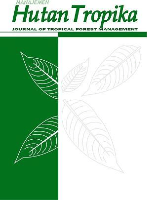
Jurnal Manajemen Hutan Tropika
Empowering ecological understanding through open access.Jurnal Manajemen Hutan Tropika, with ISSN 2087-0469 and E-ISSN 2089-2063, is an esteemed academic journal published by the Bogor Agricultural University, Faculty of Forestry in Indonesia. Since its inception in 1999 as an Open Access journal, it has been dedicated to advancing knowledge in the fields of ecology, forestry, and related environmental sciences. Aiming to provide a robust platform for disseminating research, it has achieved notable rankings within Scopus, including a Q3 classification in Ecology and Ecology Evolution, as well as a Q2 ranking in Forestry for 2023. The journal's commitment to open access ensures that vital research findings are readily available to researchers, professionals, and students alike, fostering collaboration and innovation in tropical forest management. Located at KAMPUS IPB DARMAGA, BOGOR, JAWA BARAT, this journal continues to be a significant resource for enhancing sustainable forest practices and contributing to ecological understanding in the region and beyond.